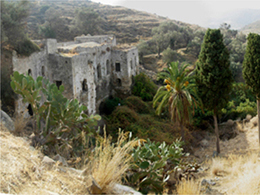STUDENTS PROJECTS
2010

21 January, 2011
Environmental education centre (Monastery of Jesuits in Naxos)
Naxos, the largest island of the Cyclades, is especially known for its rich subsoil, the fertile land and monuments, and prehistoric history.
Students : Papadopoulou Sophia, Vallindra Vasiliki
Professors: Stavros Stavridis, Vasilis Tsouras
Presentation Date: 03/11/2009
Dissertation Thesis at the National Technical University of Athens School of Architecture.
Naxos, the largest island of the Cyclades, is especially known for its rich subsoil, the fertile land and monuments, and prehistoric history. Our goal is to study, redefine and redesign such an important monument today, which unfortunately is deserted.

Almost a kilometer outside the village Melanes, after a sharp left turn, pops up in front of you, the palace complex of Kalamitsia in a natural environment. The first historical reference to the complex is from a source of Jesuit monks in 1683, who used the palace as a resort until 1773. Subsequently, the management passed to the Order of Lazariston who stayed on Naxos by 1877, while the last period begins with the arrival of the Order of Selesianon monks and was completed in 1927. Finally in 1949, the whole property of Catholic orders was expropriated by the Greek government and clergy was distributed to landless farmers of the island.

The complex comprises a main building, which probably included the official reception area, living rooms and bedrooms of the monks, while in the basement were storage areas, an oilpress and a source of water.

Two other clusters of sites with the main building were the bordes of a courtyard. These two complexes housed the creamery, furnaces, stables and possibly some storage space.
The last building of the complex is the pigeon-loft. It is located on the north side of the complex outside the protected area of the remaining buildings of the complex and yet close to it.

It should be noted however that the premises of the complex was not made together but in successive time phases to meet the needs of the monks who lived there. Because of this reason we find different types of openings, different construction of the coverage of the roofing and the closure of certain openings.

Today, because of abandonment and vandalism of the complex that has undergone over time, it decay, with significant damage to the roof and walls.

Through this thesis we want to emphasize the value of the complex and suggest a new feature that could be accommodated there, and to highlight the buildings and the natural environment.
The new use we propose is an environmental education center that will be addressed to the inhabitants of the island and to overseas visitors of all ages. The aim will be to familiarize young people with environmental conservation and land management, and research to improve agricultural activities, the main source of revenue for the island of Naxos.


Thus, the visitor encounters a number of research laboratories, laboratory of physical-chemistry, biology, agronomy and computers, a library and reading room which is open to all visitors to the complex, accommodation for students who visit the center for a period of 2 to 6 days, exhibition spaces that will show the function of the complex and its history, while the circulation and movements in the open space have been specifically studied, and the liquid component has been highlighted.

In conclusion, all the changes on the entire building are made with respect to the original shell, taking into account materials and construction principles that existed when the group operated. For this reason, we attempt to make the least possible interventions in the outer shell, while offering a viable and functional environment for visitors.











